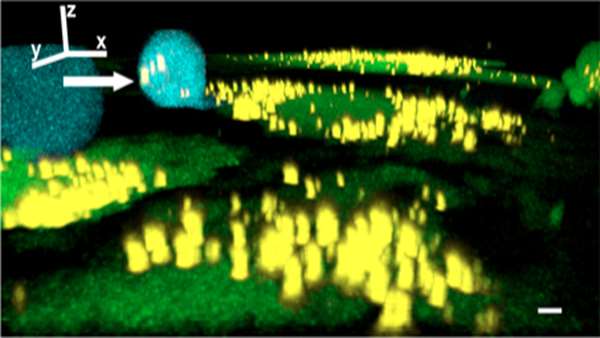A new signaling system for blood regeneration
A group of researchers, led by HSCI Co-Director David Scadden, MD, has shown that bone cells pass packets of genetic material directly to bone progenitors, increasing blood production and stimulating the immune cells necessary to fight infection.
A group of researchers, led by HSCI Co-Director David Scadden, MD, has shown that bone cells pass packets of genetic material directly to bone progenitors, increasing blood production and stimulating the immune cells necessary to fight infection.
Blood is one of the most regenerative substances of our body and production of new blood cells increases dramatically with stress states like infection. Defining how the body knows when to turn on and when to turn off blood cell production has led to discoveries of hormones (cytokines) that are now important medicines. As documented in a new paper in Cell Stem Cell, investigators at the Harvard Stem Cell Institute and Massachusetts General Hospital have discovered a new process that is independent of hormones and rapidly increases immune cells necessary to fight infection.
Based on observations in the bone marrow where blood cells are made, Youmna Kfoury, PhD, and colleagues in the laboratory of David Scadden, MD, demonstrated that vesicles from bone cells pass packets of material directly to blood progenitors. These packets, fragments of the bone cells, contain very specific RNA payloads. While many different types of RNA are in the fragments, they carry a particular abundance of processed tRNA, a type of RNA critical for converting information comprising a gene into a protein. The processed tRNAs (also called tiRNAs) have the unexpected property of rapidly increasing protein production in the receiving cell. This delivery gives the receiving cells a jumpstart on making new blood cells, with the overall result of more new blood cells and a greater ability to handle severe infection – all while sidestepping the more complex process involving cytokines.
“While it is known that vesicle transfer occurs in cell cultures outside of the body, we were able to show that this exchange actually happens in the body, in the bone marrow,” said Scadden, co-director of the Harvard Stem Cell Institute.
The direct delivery of tiRNA by vesicles is a new form of signaling between cells and does not depend on the complex signal cascades used by hormones or cytokines. Rather, tiRNA acts directly to activate the cell making machinery. Since this process is increased under conditions of stress, it is likely that it is an alternative strategy used by nature to respond to challenges.
“The beauty of the cytokine or the hormone is that it's very specific,” said Scadden. “But when it interacts with the receiving cell, that receiving cell has to have the necessary hardware to get the message. This direct transfer doesn't require all those intermediate steps. The vesicle just goes in, merges and activates the receiving cell.”
These results provide new insight into how the body uses multiple methods to improve our resilience. Harnessing this method may provide a new approach to improving defense against severe infection.
“This is an important part of the way a tissue can respond to stress,” said Scadden. Noting the current therapeutic uses of RNA transfers in both cancer treatment and vaccine development, he highlights the process as an important avenue of study. “RNA is becoming increasingly recognized for its powerful therapeutic application,” he said. “This gives us a different way of thinking about how the body orchestrates, what it needs to, to be adaptive and resilient to stress.”
Ref: https://hsci.harvard.edu/news/new-signaling-system-blood-regeneration




ارسال به دوستان